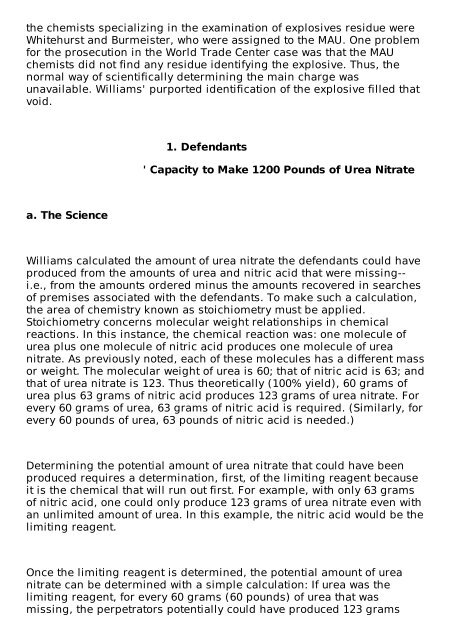linked - Investigating the Terror
linked - Investigating the Terror
linked - Investigating the Terror
You also want an ePaper? Increase the reach of your titles
YUMPU automatically turns print PDFs into web optimized ePapers that Google loves.
<strong>the</strong> chemists specializing in <strong>the</strong> examination of explosives residue were<br />
Whitehurst and Burmeister, who were assigned to <strong>the</strong> MAU. One problem<br />
for <strong>the</strong> prosecution in <strong>the</strong> World Trade Center case was that <strong>the</strong> MAU<br />
chemists did not find any residue identifying <strong>the</strong> explosive. Thus, <strong>the</strong><br />
normal way of scientifically determining <strong>the</strong> main charge was<br />
unavailable. Williams' purported identification of <strong>the</strong> explosive filled that<br />
void.<br />
a. The Science<br />
1. Defendants<br />
' Capacity to Make 1200 Pounds of Urea Nitrate<br />
Williams calculated <strong>the</strong> amount of urea nitrate <strong>the</strong> defendants could have<br />
produced from <strong>the</strong> amounts of urea and nitric acid that were missing-i.e.,<br />
from <strong>the</strong> amounts ordered minus <strong>the</strong> amounts recovered in searches<br />
of premises associated with <strong>the</strong> defendants. To make such a calculation,<br />
<strong>the</strong> area of chemistry known as stoichiometry must be applied.<br />
Stoichiometry concerns molecular weight relationships in chemical<br />
reactions. In this instance, <strong>the</strong> chemical reaction was: one molecule of<br />
urea plus one molecule of nitric acid produces one molecule of urea<br />
nitrate. As previously noted, each of <strong>the</strong>se molecules has a different mass<br />
or weight. The molecular weight of urea is 60; that of nitric acid is 63; and<br />
that of urea nitrate is 123. Thus <strong>the</strong>oretically (100% yield), 60 grams of<br />
urea plus 63 grams of nitric acid produces 123 grams of urea nitrate. For<br />
every 60 grams of urea, 63 grams of nitric acid is required. (Similarly, for<br />
every 60 pounds of urea, 63 pounds of nitric acid is needed.)<br />
Determining <strong>the</strong> potential amount of urea nitrate that could have been<br />
produced requires a determination, first, of <strong>the</strong> limiting reagent because<br />
it is <strong>the</strong> chemical that will run out first. For example, with only 63 grams<br />
of nitric acid, one could only produce 123 grams of urea nitrate even with<br />
an unlimited amount of urea. In this example, <strong>the</strong> nitric acid would be <strong>the</strong><br />
limiting reagent.<br />
Once <strong>the</strong> limiting reagent is determined, <strong>the</strong> potential amount of urea<br />
nitrate can be determined with a simple calculation: If urea was <strong>the</strong><br />
limiting reagent, for every 60 grams (60 pounds) of urea that was<br />
missing, <strong>the</strong> perpetrators potentially could have produced 123 grams


